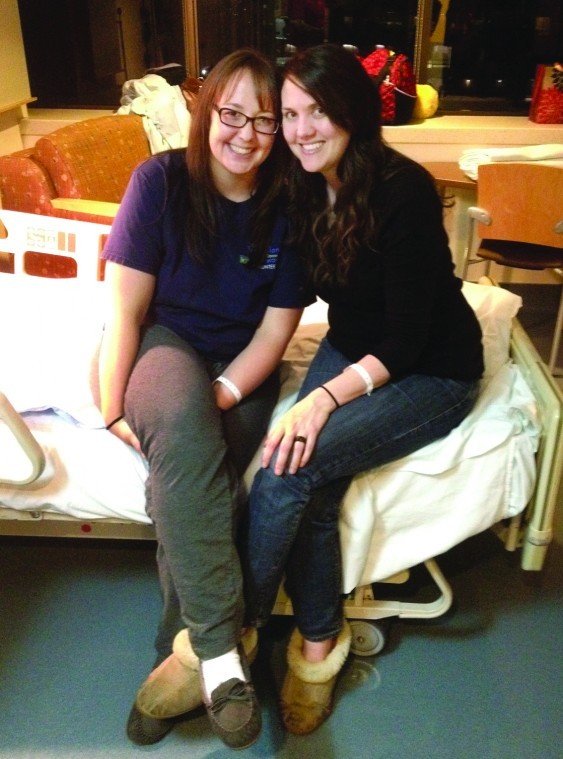Causing a rattle that would make a den of diamondbacks jealous, Casey Johansen plopped a clattering, shoe box-sized pill carrier on her kitchen table.
Unfastening one of many small plastic flaps, this one marked “Thursday,” she scooped up a handful of multi-colored meds – reds, whites, yellows – and placed them in a tight pile.
“It’s insane. Morning, noon and night,” the 22-year-old said, standing in the kitchen of her Gilroy home off Buena Vista Avenue last Wednesday afternoon.
Antivirals, antibiotics, antifungals and a host of others – she takes about 35 pills each day at precise times. She expects to gulp down the glut of pills for another year. After that, she’ll have to pop at least five of them every day for the rest of her life.
“But everything will be cut down as time goes on,” she said.
Fortunately, time is something Johansen now has. A new life and a new outlook, all thanks to an early Christmas present: half her older sister’s liver.
Johansen, who’s battled confounding liver illnesses since age 8, including a rare bile duct disease, once feared an early death. Now, she says she could feel a difference “within a couple of days” after waking up Nov. 17 at the University of California, San Francisco Medical Center with the new vital organ.
“I feel more mentally clear, I have more energy. I’ve read two novels since I’ve been out of the hospital. I hadn’t been able to read a whole novel in two, three years,” said Johnson, whose disease she said forced her to drop out of school because it made her mind cloudy and kept her from concentrating in class. “It’s a complete difference. It makes me excited about going back to work and going back to school.”
Maybe most exciting of all is how she got the liver.
Her older sister – Autumn Hall, 35 – is Johansen’s living donor, meaning surgeons cut out a healthy, hefty segment of Hall’s liver, which luckily happened to be larger than average, and transplanted it in Johansen with the hope that both halves would regenerate and function normally.
So far, so good. And it’s about time, the sisters say.
“I had pretty much had always planned to be the donor,” Hall said, holding her 16-month-old, red-headed son Samuel in her parents’ home just east of Gilroy. “Unless things got tragic, we knew that we were going to go with the living donor. For me, it was just like, ‘OK, let’s do it.’ ”
Without the transplant, tragedy was certain, Johansen said. The disease, known as “primary sclerosing cholangitis,” eventually would lead to her death following years of infections, emergency room visits and the grim possibility of bile duct cancer, a devastating illness that claimed the life of Hall of Fame football player Walter Payton in 1999.
“I would be pretty close to bedridden all the time,” Johansen said.
There’s no known cause of primary sclerosing cholangitis, according to the U.S. National Library of Medicine. The condition is more common in men than women and is rare in children.
And lumped with more than 16,000 others also waiting for a new liver, according to the national Organ Procurement and Transplantation Network, Johansen said she’d likely be waiting until it was too late.
“At 22, that’s kind of a crappy place to be,” she said.
That nightmare scenario seems, fingers crossed, a thing of the past.
“Casey is one tremendous story – the fact that she was able to find a person who matched and was willing to donate a liver to her,” said Anthony Borders, communications specialist for the California Transplant Donor Network. “And as a result, we hope Casey will have many, many more years of life.”
“It’s a message of helping,” Borders added. “And it’s one we should always try to emulate.”
With mom, dad and their third daughter, Riane, 19, praying in a hospital waiting room, the surgery lasted a combined nine hours – two hours short of doctors’ estimates. The sisters returned home after recovery stints at UCSF, Johansen (10 days) and Hall (6 days). They’ll keep their scars a little longer, especially Johansen, whose incision marks from just below her chest to belly button are dubbed “the Mercedes” because they resemble the car company’s logo.
With broad smiles, the sisters recall the only ones who seemed outwardly timid about the surgery were, in fact, the surgeons, who constantly referred to the impending procedure as “tentative,” cautioning that there was a way out right up until the incision.
“It was actually a question of whether or not the surgeons felt comfortable,” Hall said. “I was actually afraid they were going to say no.”
It’s a risky procedure that potentially can kill the donor and the recipient, and, in this case, create a widower out of Hall’s husband, Jason, who would be left to raise their young son.
“I’ve always known it was going to be fine,” Hall said.
Though the sisters now share two halves of a liver and describe their relationship as “pretty fairly close,” they aren’t exactly peas in a pod.
“The rational side of me said things were going to work out,” Johansen said about the surgery.
“You’re rational?” Hall rebutted jokingly.
Hall, who along with her husband, has taken a leave of absence from life as Assemblies of God missionaries in Biloxi, Miss., said she remained steady. Johansen, however, admits wasn’t sure how she’d react when it came time for surgery.
“I was trying not to think about it for the first couple weeks (after the operation date was set),” she said. “I was convinced that the moment I got to the hospital, I was going to have a panic attack. I was convinced I was going to have a breakdown.”
With two of her three daughters in the middle of a risky, but necessary, surgery, Gerra Johansen struck a balance between concern and comfort.
“(We thought about) how dangerous it was for both of them. We thought about complications, that we could lose two of our daughters at the same time,” she said. “We were praying all day that everything would be fine. In the back of our mind, there was always that possibility that something could go wrong.”
Rest and recovery for the sisters has been slow but steady. Hall can finally lift up her 27-pound son, inciting giggles from the beaming redhead.
Johansen can set her sights back on school and her career. She’ll attend one of three colleges – California State University, East Bay; San Jose State University; or the University of San Francisco. Wherever she enrolls, the recent transplant recipient who’s spent the last two years as an organ donation advocate will fittingly study the ins and outs of public health.
In the meantime, the family is happily adjusting with the miraculous idea that their two oldest daughters – including one who faced a depressingly uncertain future – seem to be out of the woods.
“They’re still both in great shape. There’s been no rejection issues. They both look good, and they’re feeling fine,” Gerra said. “We’re kind of starting to relax.”














